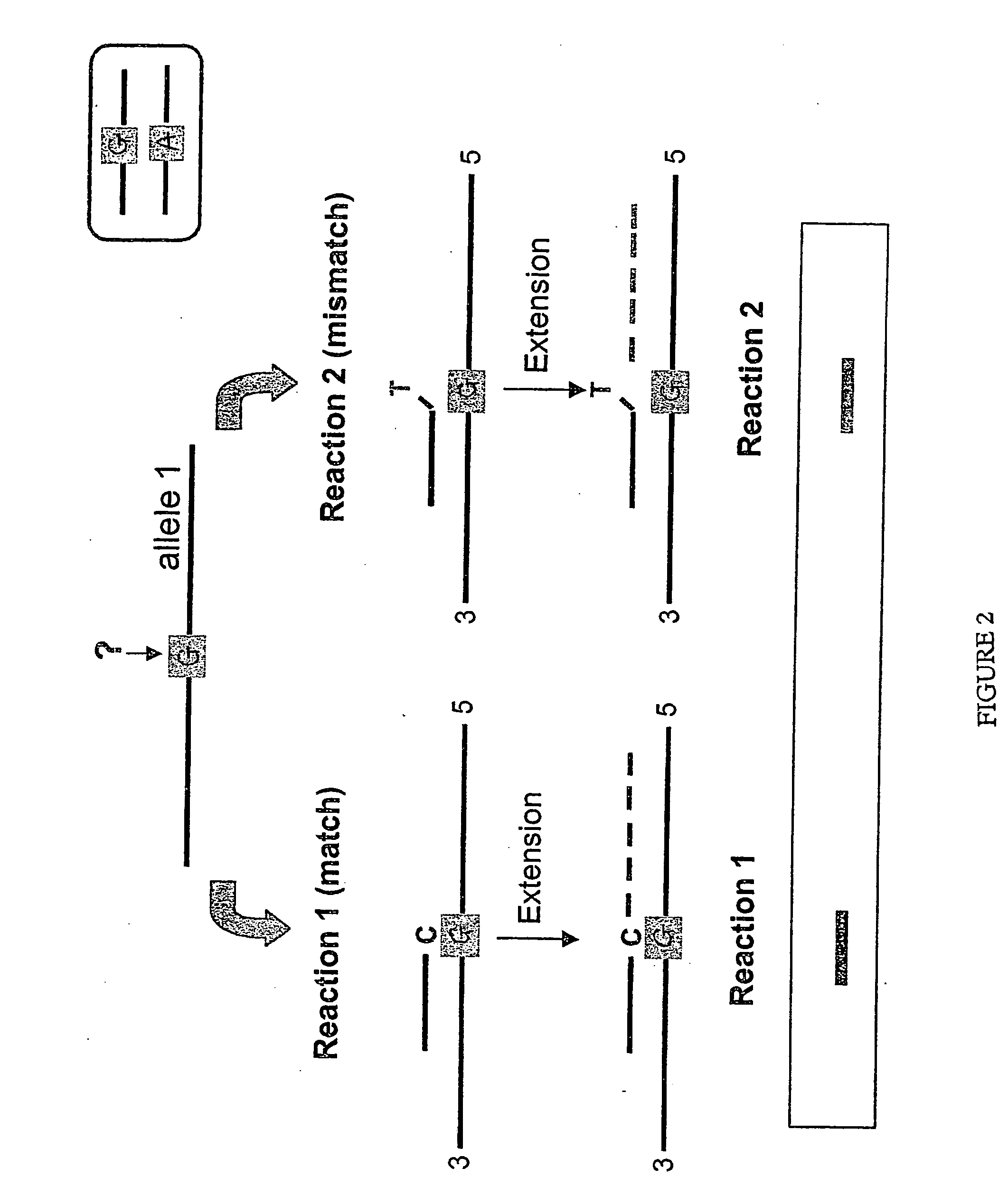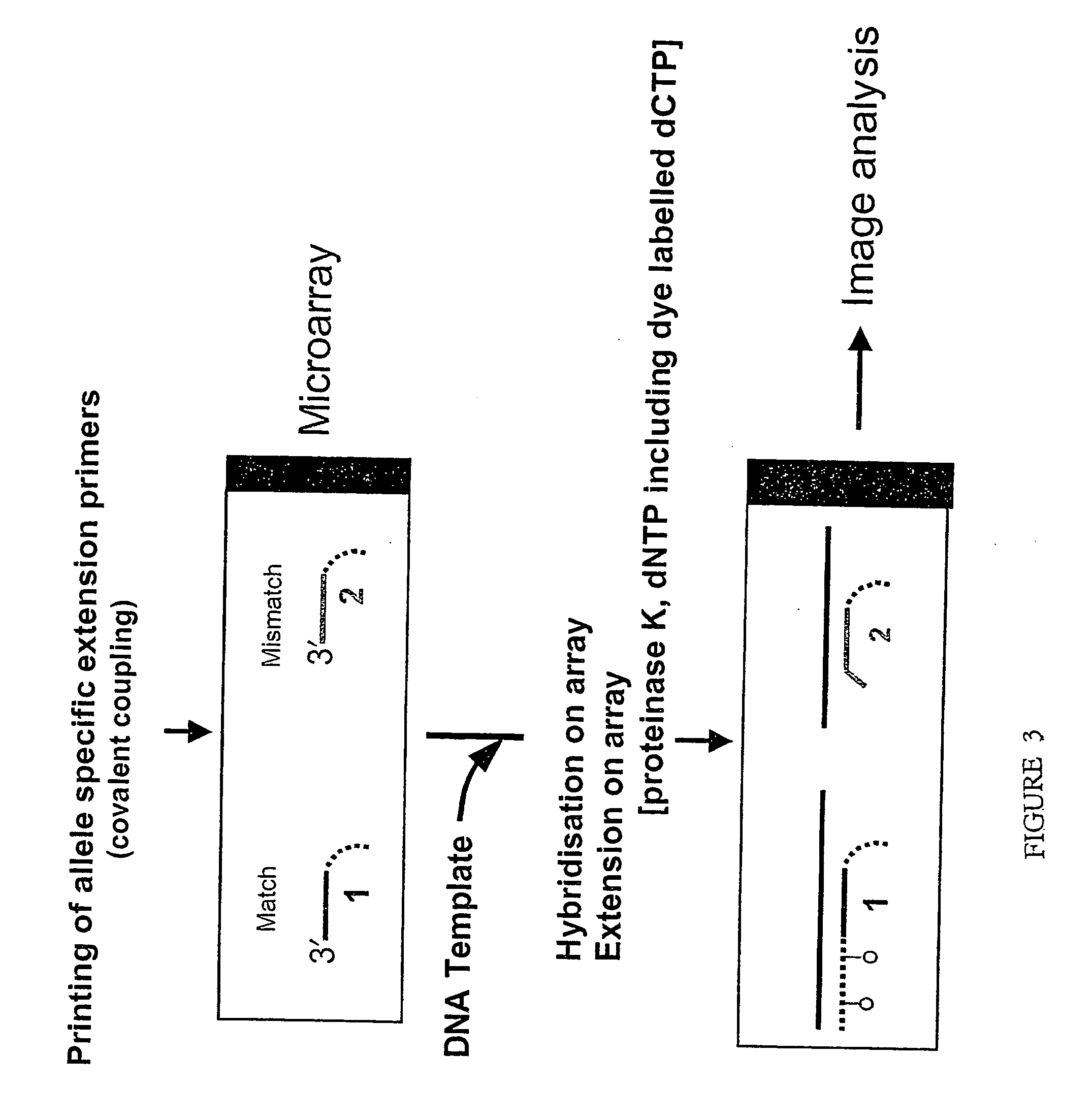Allele-specific mutation detection assay
a technology of allele-specific mutation and detection assay, which is applied in the field of allele-specific assay, can solve the problems of insufficient culture of hpv in vitro, almost entirely classification, and still under deba
- Summary
- Abstract
- Description
- Claims
- Application Information
AI Technical Summary
Benefits of technology
Problems solved by technology
Method used
Image
Examples
example 2
Proteinase-Mediated Allele-Specific Primer Extension (PrASE) on DNA Microarrays—Re-Sequencing of Part of the p53 Tumor Suppressor Gene
[0166] In this Example, the microarray assay has been used to re-sequence a 7-base stretch in exon 5 of the p53 tumour suppresser gene. Partially overlapping extension primers were designed, but instead of two variants differing only in the 3′-terminus nucleotides as for SNPs, all four possible variants of 3′-terminus were used. Thus, four primers were designed, each with a different base at the 3′ end. The use of all four possible variants of 3′-terminus allele-specific primers allows detection of all possible mutations instead of two allelic variants. To perform detection and characterization of mutations in these 7 bases, 28 partially overlapping oligonucleotides were spotted on the chip. These extension primers were then allowed to hybridize to a synthetic 60-mer oligonucleotide template, followed by extension in situ using fluorescent labelled ...
example 3
SNP Genotyping by Multiplex Liquid-Phase Proteinase-Mediated Allele-Specific Primer Extension (PrASE) by Using Generic Oligonucleotide Arrays
[0178] The results presented here provide a solution to one of the major obstacles in allele-specific primer extensions: to accurately score single nucleotide polymorphisms (SNPs). Certain mismatched configurations are known to yield extension products and hinder proper discrimination between genotypes, and consequently limiting the use of this very convenient approach. This Example describes an accurate single step extension approach suitable for high-throughput SNP typing applications. The method relies on multiplex SNP analysis by extension of paired allele-specific primers for each SNP position. In addition, in order to obtain accurate genotyping data, the method relies on the use of a thermo-stable protein degrading (digesting) enzyme, Proteinase K, in the extension reactions. In this method, we have taken advantage of the fact that DNA ...
example 4
Viral and Microbial Genotyping by a Unique Combination of Multiplex Competitive Type-Specific Hybridization and Proteinase-Mediated Allele-Specific Extension Followed by Hybridization to Generic Oligonucleotide Arrays
Background
[0190] Human papillomaviruses (HPV) are small, non-enveloped DNA viruses that are believed to be an important contributing factor in the etiology of certain benign and malignant tumorous lesions in humans such as cervical cancer. At present, there are more than 100 different HPV genotypes have been identified based on differences in DNA sequence. Human papillomaviurses are classified in low- and high-risk genotypes based on their oncogenic potential in anogential epithelia. Furthermore, this classification is almost entirely based on molecular characteristics and still under debate.
[0191] A wide variety of techniques have been used for HPV genotyping. HPV cannot be adequately cultured in vitro and serological assays only have limited accuracy, since they ...
PUM
| Property | Measurement | Unit |
|---|---|---|
| temperature | aaaaa | aaaaa |
| temperature | aaaaa | aaaaa |
| temperature | aaaaa | aaaaa |
Abstract
Description
Claims
Application Information
 Login to View More
Login to View More - R&D
- Intellectual Property
- Life Sciences
- Materials
- Tech Scout
- Unparalleled Data Quality
- Higher Quality Content
- 60% Fewer Hallucinations
Browse by: Latest US Patents, China's latest patents, Technical Efficacy Thesaurus, Application Domain, Technology Topic, Popular Technical Reports.
© 2025 PatSnap. All rights reserved.Legal|Privacy policy|Modern Slavery Act Transparency Statement|Sitemap|About US| Contact US: help@patsnap.com



